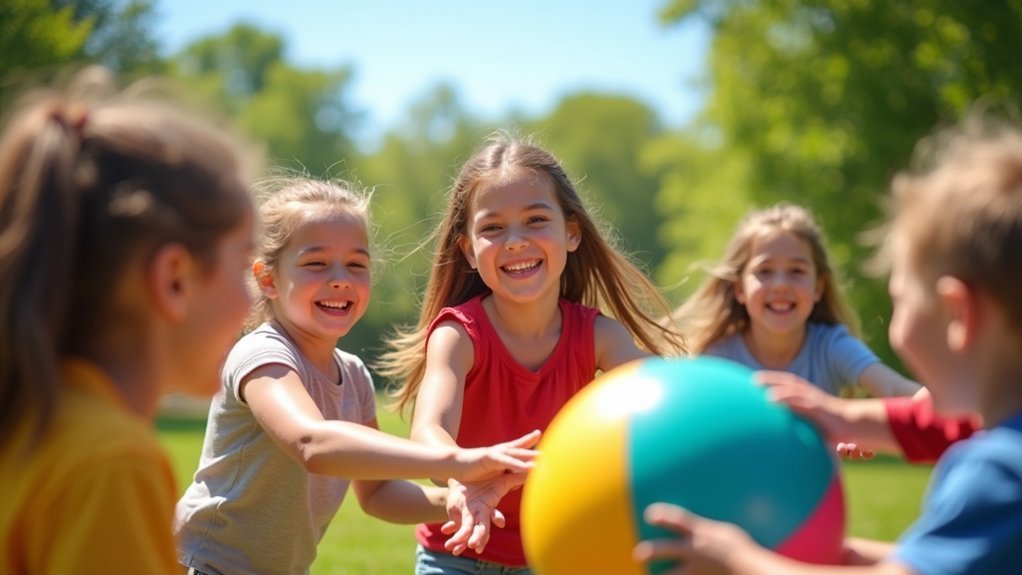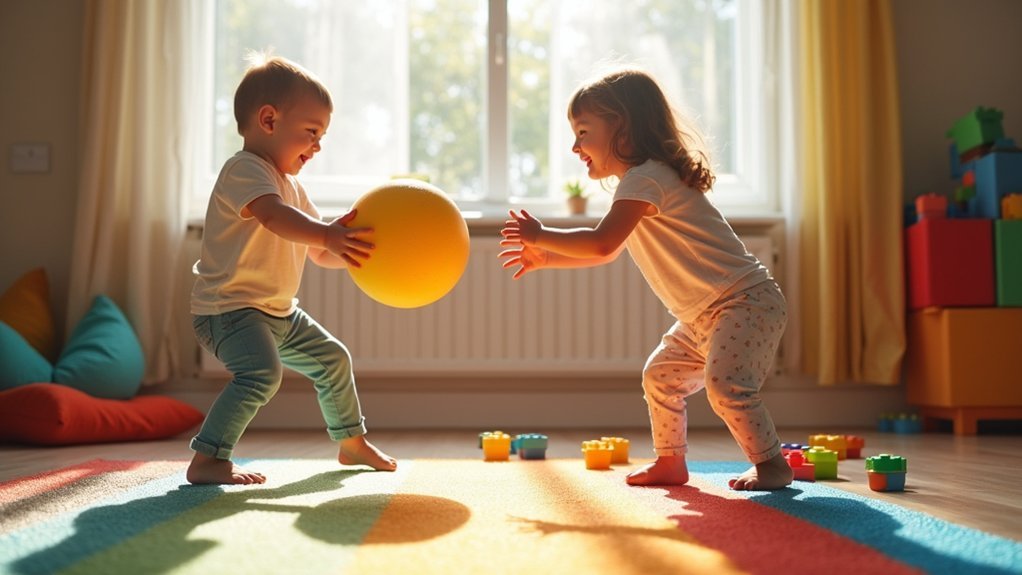Coordination games help autism development by providing structured opportunities to practice movement sequences while improving crucial motor skills often challenging for children on the spectrum. They offer essential proprioceptive input, enhance sensory integration, and build neural pathways supporting cognitive functions. You’ll notice benefits in social interaction as children focus on shared physical goals rather than forced exchanges. These activities create a developmental pathway from gross to fine motor skills, establishing foundations for independence and confidence in daily activities.
Why Do Coordination Games Help Autism Development?

While traditional therapies address many aspects of autism, coordination games provide unique developmental benefits that make them particularly effective. These activities directly target motor planning challenges common in autism by creating structured opportunities to practice movement sequences in enjoyable settings.
Coordination games offer autism-specific benefits by providing structured, enjoyable practice for motor planning challenges.
You’ll notice improvements in hand-eye coordination skills as your child engages in activities requiring precise movements, which transfers to everyday tasks like buttoning shirts or using utensils.
Unlike passive interventions, these games function as dynamic sensory integration therapy, helping your child process and respond to sensory input more effectively.
Perhaps most importantly, coordination games naturally encourage social interaction through partner work and group play, creating authentic opportunities for communication development while children focus on shared physical goals rather than forced social exchanges.
The Connection Between Motor Skills and Autism
Although often overlooked in favor of social and communication concerns, motor skill challenges represent a core aspect of autism that affects daily functioning. Research consistently shows that children on the autism spectrum disorder score lower on praxis tests compared to their peers, revealing significant coordination difficulties.
These motor challenges stem partly from sensory processing differences that interfere with the brain’s ability to integrate visual input with physical actions.
When your child struggles to coordinate movements, everyday tasks become more difficult, potentially limiting their independence and social opportunities.
Building Sensory Integration Through Structured Play

Structured play activities create powerful proprioceptive input opportunities for your autistic child, helping them develop essential awareness of their body’s position and movement.
You’ll notice improvements in your child’s coordination as these games encourage them to process and integrate various sensory signals simultaneously.
Incorporating visual patterns into movement exercises strengthens their visual-motor connections, enabling them to better sequence actions and respond appropriately to their environment.
Proprioceptive Input Benefits
Because children with autism often experience challenges with sensory integration, proprioceptive input through coordination games offers substantial developmental advantages.
When your child engages in activities involving pushing, pulling, or climbing, they’re receiving essential feedback about their body’s position in space.
These coordination games stimulate the proprioceptive system, improving body awareness and motor skills while simultaneously reducing sensory-seeking behaviors.
You’ll notice that structured play activities incorporating proprioceptive input can greatly enhance your child’s balance and motor planning abilities.
Regular participation in these activities also promotes emotional regulation and focus as your child’s brain learns to process sensory information more effectively.
As they master coordination games providing proprioceptive feedback, you’ll likely observe increased confidence in their physical abilities and improved overall sensory integration.
Visual-Motor Pattern Formation
Closely related to proprioceptive benefits is the improvement of visual-motor pattern formation through coordination games. Your autistic child faces unique challenges with sensory processing that affect how they synchronize what they see with their physical movements.
Through structured activities like throwing and catching games, you’ll help improve hand-eye coordination essential for everyday tasks including writing and self-care.
Research by Green et al. (2002) confirms that play-based therapy considerably enhances motor planning in children with autism. When your child participates in activities like obstacle courses, they’re not just having fun—they’re processing multiple sensory inputs simultaneously, strengthening their ability to form visual-motor patterns.
These games create opportunities for meaningful social engagement while building confidence in movement skills that translate to improved daily functioning.
How Balance Activities Support Cognitive Development
Balance activities help your child’s brain create essential neural pathways that support learning and problem-solving abilities.
When your child practices standing on one foot or maneuvering a balance beam, they’re strengthening connections between different brain regions responsible for processing spatial information.
These exercises enhance their ability to understand where their body is in space, which directly transfers to improved attention, memory, and logical thinking skills.
Neural Pathway Formation
When children with autism engage in coordination games, their brains forge essential neural connections that might otherwise develop atypically. These activities promote neural pathway formation by integrating sensory information vital for developing cognitive skills.
As your child participates in balance activities, they’re actually stimulating their motor cortex, improving communication between brain regions involved in motor planning and execution. This neuroplasticity is fundamental for learning new skills and adapting to challenges.
- Balance games increase gray matter in brain areas responsible for motor control
- Regular coordination activities strengthen neural connections through consistent practice
- Your child’s brain adapts by creating more efficient pathways between sensory input and motor output
- These strengthened neural networks support attention, problem-solving, and visual-motor processing
Spatial Processing Enhancement
Through movement-based activities, your child’s spatial processing abilities undergo significant enhancement, creating a foundation for advanced cognitive development.
Balance activities improve spatial awareness by helping your child understand their body’s position relative to their environment, which is essential for maneuvering through daily life.
When your child engages in coordination games, they’re developing proprioception—the ability to estimate distances and force needed for physical tasks.
This skill directly supports cognitive development by improving focus and attention as they learn to control their movements more effectively.
You’ll notice that spatially demanding activities encourage problem-solving skills as your child strategizes to overcome obstacles.
Regular practice builds confidence in physical abilities, making them more willing to tackle new experiences.
These spatial processing improvements extend well beyond physical benefits into broader cognitive functioning.
Adaptive Equipment That Enhances Coordination Practice

As children with autism develop coordination skills, appropriate adaptive equipment becomes essential for effective practice and meaningful progress. The right tools can greatly improve your child’s engagement with fine motor tasks while providing necessary sensory input to enhance focus.
Supporting coordination development through specialized adaptive tools creates the foundation for both independence and confidence in children with autism.
- Weighted utensils and adaptive tools offer tactile feedback that helps your child maintain attention during coordination activities.
- Visual aids like color-coded targets make exercises more accessible and improve response to visual cues.
- Touchscreen devices provide interactive games that develop precise hand movements and visual-motor integration.
- Balance boards and stability balls strengthen core stability, which forms the foundation for overall coordination development.
Social Benefits of Group Coordination Games
While physical skills development remains essential, group coordination games offer profound social advantages for children with autism that extend far beyond motor proficiency. These activities create opportunities for your child to connect with peers while building vital social skills.
| Benefit | Impact on Children with Autism |
|---|---|
| Social Skills | Improves turn-taking and sharing abilities |
| Communication Skills | Enhances expression and response to others |
| Peer Relationships | Fosters sense of belonging, reducing isolation |
| Self-Esteem | Builds confidence for broader social engagement |
When your child participates in group coordination activities, they’re not just playing—they’re practicing emotional regulation by managing excitement and frustration in real-time. The structured interaction helps them feel included while developing the confidence to engage socially in various environments beyond the game setting.
Creating Successful Movement Experiences for Autistic Children
Despite individual differences in sensory processing and motor abilities, creating effective coordination activities for your autistic child requires thoughtful planning and personalization.
When designing experiences that support Motor Skill Development, focus on activities that improve core stability and enhance body awareness.
- Start with structured, predictable routines that gradually introduce new movements.
- Incorporate sensory preferences that make physical therapy exercises more engaging.
- Break down complex movements into manageable steps that build confidence.
- Create a distraction-free environment with clear visual supports for each activity.
Remember to celebrate small achievements.
Progress isn’t measured in leaps but in tiny steps forward. Each small victory builds your child’s confidence and foundation.
Even minor improvements in coordination greatly impact daily functioning.
The Role of Rhythm and Timing in Motor Planning
Rhythmic patterns serve as powerful scaffolding for developing motor planning abilities in autistic children. When you incorporate rhythm-based activities into coordination games, you’re helping your child build neural pathways that connect auditory cues with physical responses.
| Rhythm Benefits | Motor Outcomes |
|---|---|
| Predictable structure | Improved sequencing |
| Auditory guidance | Enhanced timing accuracy |
| Sensory organization | Better coordination |
You’ll notice your child’s motor skills improve as they engage with these structured rhythmic activities. Simple games like clapping patterns or drumming help break down complex movements into manageable steps, making coordination challenges less overwhelming. The timing element creates anticipation skills that transfer to daily activities, while the enjoyable nature of rhythm-based games increases engagement. This combination makes rhythm an essential component in supporting your child’s motor development journey.
From Gross to Fine Motor Skills: A Developmental Pathway
Understanding the developmental progression from gross to fine motor skills provides you with a roadmap for supporting your autistic child’s coordination journey. Children typically master large movements before refining smaller, more precise actions—a sequence that’s especially important for children with autism who often experience delays in motor development.
Following your child’s natural motor development—from big movements to small ones—creates a foundation for building coordination skills in autism.
When you engage your child in coordination games, you’re helping them:
- Build fundamental gross motor skills through running, jumping, and climbing activities
- Gradually improve hand-eye coordination through throwing and catching exercises
- Develop fine motor precision needed for drawing, writing, and self-care tasks
- Process sensory information more effectively, which supports better motor planning
This developmental pathway isn’t linear—your child might excel in some areas while needing more support in others. Consistent practice will help integrate these skills naturally.
Measuring Progress in Coordination Development
You’ll find tracking your child’s coordination development more manageable by focusing on clear developmental milestones, such as improved balance, refined grasp, or successful two-handed activities.
Daily routines like mealtime, dressing, and playtime offer natural opportunities to observe and document subtle improvements in your child’s motor skills.
Consider recording short videos every few weeks during the same activity to create a visual timeline that highlights progress you might otherwise miss in day-to-day interactions.
Measurable Developmental Milestones
Progress in coordination skills provides concrete evidence of developmental advancement in children with autism. When you track these measurable developmental milestones, you’ll gain valuable insights into your child’s coordination development journey.
Through standardized assessments like the Bruininks-Oseretsky Test, you can establish clear benchmarks to monitor improvements.
- Gross motor achievements become visible when your child masters running, jumping, and throwing during structured play activities.
- Fine motor skills development appears through improved performance in tasks requiring manual dexterity like buttoning and threading.
- Hand-eye coordination advancements can be quantified through observing increased accuracy in catching and throwing.
- Documentation of new abilities, such as participation in group games, creates a tangible record of your child’s developmental progress.
Tracking Through Daily Activities
While formal assessments provide valuable benchmarks, your daily interactions offer rich opportunities to monitor your child’s coordination development. Pay attention to how they handle routine tasks like buttoning shirts, using utensils, or organizing toys. These observations reveal meaningful progress that standardized tests might miss.
Consider keeping a simple journal documenting successful coordination moments—catching a ball, completing a puzzle, or tying shoelaces. This tracking progress method highlights improvements and identifies areas needing focus.
Transform everyday activities into purposeful practice: grocery shopping becomes a chance to improve hand-eye coordination as they select and place items in a cart. Bath time offers opportunities to pour and manipulate objects in water.
Your consistent documentation of these daily tasks provides invaluable insights into your child’s development journey.
Video Progress Documentation
Capturing your child’s coordination milestones through video creates a powerful visual timeline of their development journey. As your child develops the skills they need through coordination games, recording their progress enables you to notice subtle improvements that might otherwise go unrecognized.
Video progress documentation offers several benefits:
- Helps therapists identify specific areas where your child needs additional support to improve hand-eye coordination
- Provides motivating visual evidence that shows your child how far they’ve come
- Facilitates meaningful discussions between you and therapy professionals about effective strategies
- Creates evidence-based records that can justify continued therapeutic interventions and support
Parent-Facilitated Games for Home Practice
Because regular practice is essential for developing coordination skills in children with autism, the home environment offers an ideal setting for consistent, comfortable learning. You’ll find that parent-facilitated games can greatly improve your child’s hand-eye coordination and motor skills through activities they enjoy.
| Game Type | Benefits for Children with Autism Spectrum |
|---|---|
| Ball Play | Enhances hand-eye coordination and turn-taking |
| Obstacle Courses | Improves balance and spatial awareness |
| Animal Walks | Strengthens core stability and body awareness |
| Yoga Poses | Develops flexibility and postural control |
| Follow-the-Leader | Builds imitation skills and motor planning |
When you incorporate these activities into daily routines, you’re creating opportunities for your child to practice vital coordination skills in a familiar setting. Remember to provide positive reinforcement—your enthusiasm and praise will motivate continued engagement and progress.
Frequently Asked Questions
How to Help an Autistic Child With Coordination?
You’ll improve your child’s coordination through targeted games, visual aids, and consistent practice. Try animal walks, obstacle courses, and throwing activities. Incorporate their interests, use adaptive tools, and celebrate small achievements.
Why Are Sensory Activities Good for Autism?
Sensory activities help you regulate sensory input, reducing overwhelm. They’ll improve your motor skills, body awareness, and cognitive development. You’ll also build social connections as you explore different textures, sounds, and movements in a controlled environment.
Why Does Autism Affect Coordination?
Autism affects your coordination because your brain processes sensory information differently. You’ll struggle with motor planning, proprioception, and body awareness, making it harder to organize movements effectively and respond to environmental feedback.
How Does Play Help Children With Autism?
Play helps you develop essential skills for autism. You’ll improve your communication, strengthen social abilities, and enhance problem-solving through playful interactions. You’re also building emotional connections while developing imitation skills and cognitive flexibility.
In Summary
You’ve now seen how coordination games provide a powerful way to support your child’s autism development. They’re not just fun activities—they’re building blocks for sensory integration, motor planning, and cognitive skills. As you introduce these games at home, you’ll notice improvements across multiple developmental areas. Remember to celebrate small victories and adapt activities to your child’s unique needs. Every playful moment is strengthening crucial neural connections.





Leave a Reply